EPJ E Colloquium - Glassy dynamics and irreversible adsorption in thin films of soft matter
- Details
- Published on 25 June 2013
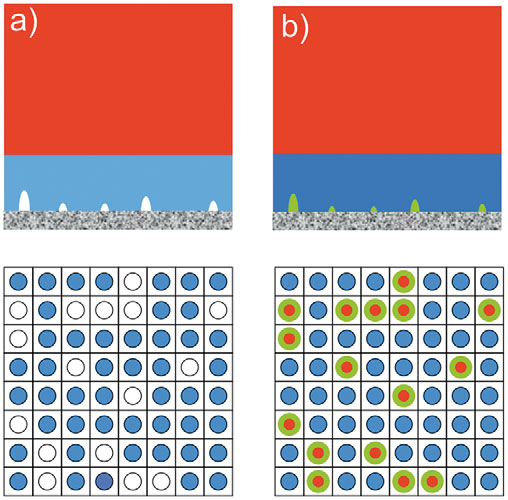
Thin films of liquids and polymers are interesting systems for those seeking to test glass transition theories and their prediction of a characteristic transition length scale of a few nanometers. The anomalous phenomena observed in some of these nano-confined films has greatly advanced our understanding of theoretical and experimental soft matter physics.
These films are treated as equilibrium systems where surfaces and interfaces introduce monotonous long-range mobility gradients. Considering finite size and interfacial effects provides an intuitive but oversimplifies picture that falls short of explaining many phenomena, such as enhancement of segmental mobility near an absorbing surface or long-lasting metastable states in the liquid.
EPJ E Highlight - How cells get a skeleton
- Details
- Published on 12 June 2013

Stress generated by nano-motors within animal cells can lead to the creation of a condensed layer of filaments beneath the outer cell membrane
The mechanism responsible for generating part of the skeletal support for the membrane in animal cells is not yet clearly understood. Now, Jean-François Joanny from the Physico Chemistry Curie Unit at the Curie Institute in Paris and colleagues have found that a well-defined layer beneath the cell outer membrane forms beyond a certain critical level of stress generated by motor proteins within the cellular system. These findings, which offer a new understanding of the formation of this so-called cortical layer, have just been published in EPJ E.
EPJ E Highlight - Microgels’ behaviour under scrutiny
- Details
- Published on 01 May 2013

A new study explores the counter-intuitive behaviour of a microgel composed of soft polymer blobs
Being a physicist offers many perks. For one, it allows an understanding of the substances ubiquitous in everyday industrial products such as emulsions, gels, granular pastes or foams. These are known for their intermediate behaviour between fluid and solid. Paint, for example, can be picked up on a paintbrush without flowing and spread under the stress of the brush stroke like a fluid. Baudouin Geraud and colleagues from the Light Matter Institute at the University of Lyon, France, have studied the flow of a microgel confined in microchannels. They have shown, in a study just published in EPJ E, that its behaviour under confinement differs from predictions based on standard theories. Indeed, its molecules are not only subjected to local forces, but also to neighbouring forces that affect its flow.
EPJ E Call for papers: Thermal non-equilibrium phenomena in multi-component fluids
- Details
- Published on 17 April 2013
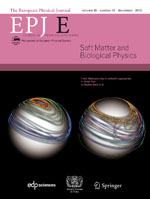
EPJE is inviting submission for a new topical issue on “Thermal non-equilibrium phenomena in multi-component fluids”. Under thermal non-equilibrium conditions, multi-component fluids generally undergo component separation. This is termed thermodiffusion in molecular liquids, and thermophoresis in colloidal fluids. The precise physical principles underlying these phenomena are still not understood, and it is envisaged that a continuous flow of ideas between theoreticians, experimental scientists and researchers employing numerical methods is needed to achieve a deeper understanding. In order to provide an overview of the more recent advances in this intriguing area, Fabrizio Croccolo and Henri Bataller will guest edit this topical issue on physical systems outside thermal equilibrium. The deadline for submission is 30 June 2014. Read the full call for papers to learn more about the scope and submission details.
EPJ E Highlight - How proteins read meta DNA code
- Details
- Published on 27 March 2013
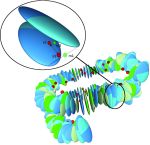
Scientists have accurately calculated the sliding mechanism for deciphering the second genetic code written within the DNA base pair sequence
Three-quarters of the DNA in evolved organisms is wrapped around proteins, forming the basic unit of DNA packaging called nucleosomes, like a thread around a spool. The problem lies in understanding how DNA can then be read by such proteins. Now, Arman Fathizadeh, a physicist at Sharif University of Technology in Tehran, Iran, and colleagues have created a model showing how proteins move along DNA, in a paper just published in EPJ E.
EPJ E Call for Papers: Irreversible dynamics
- Details
- Published on 17 March 2013
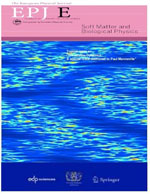
EPJE is now accepting submissions for a topical issue on “irreversible dynamics”, dedicated to Paul Manneville. The study of classical physics underwent a revolution in the 1970s-1980s thanks to seminal contributions by Ruelle, Takens, Pomeau and Manneville. The concurrent revival and extension of the theory of dynamical systems encompasses spatiotemporal chaos and coupled oscillator arrays. Applications to fluid dynamics range from pattern formation in convection, to the onset of turbulence in shear flows. The concurrent revival and extension of the theory of dynamical systems encompasses spatiotemporal chaos and coupled oscillator arrays. Applications to fluid dynamics range from pattern formation in convection, to the onset of turbulence in shear flows. Laurette Tuckerman or Patrice Le Gal, Guest Editors of this topical issue, extend a warm invitation to all researchers, with a wide interpretation of the field. The deadline for submission is July 1st 2013. The full call for papers can be found here
EPJ E Highlight - Gap geometry grasped
- Details
- Published on 10 February 2013

A new algorithm could help understand the structure of liquids, and how they flow through porous media
Theoretical physicist Moumita Maiti and colleagues at the Jawaharlal Nehru Centre for Advanced Scientific Research in Bangalore, India, have now implemented an algorithm for analysing void space in sphere packing, where the spheres need not all be the same size. This method, just published in EPJ E, could be applied to analyse the geometry of liquids present between multi-sized spheres that are akin to a model for porous material. This provides a tool for studying the flow of such fluids through porous material. More importantly, it can also be used to study the packing geometry of proteins.
EPJ E Highlight - Liquid crystal’s chaotic inner dynamics
- Details
- Published on 04 February 2013

Scientists have unearthed a new dynamic process induced by strong electric fields in thin liquid crystal cells
Liquid crystal displays are ubiquitous. Now, Polish physicists have demonstrated that the application of a very strong alternating electric field to thin liquid crystal cells leads to a new distinct dynamic effect in the response of the cells. The theory of spatio-temporal chaos explains this effect. It was elucidated by Wojciech Jeżewski and colleagues from the Institute of Molecular Physics, Polish Academy of Sciences, in Poznań, Poland, and was just published in EPJ E. This effect has implications for the operation of liquid-crystal devices because their operation is based on the electro-optic switching phenomenon, subject to the newly discovered effect.
EPJ E Highlight - Adhesion disturbed by noise
- Details
- Published on 20 December 2012

A new model could ultimately help robotic fingers, made of a soft surface, manipulate small objects
Imagine a solid ball rolling down a slightly inclined ramp. What could be perceived as child’s play is the focus of serious theoretical research by Manoj Chaudhury and Partho Goohpattader, two physicists from Lehigh University, Bethlehem, Pensylvania, USA. Their study, which has just been published in EPJ E, has one thing in common with childhood behaviour. It introduces a mischievous idea, namely studying the effect of random noise, such as vibrations, on the ball. They found it could lower the energy barrier to set the ball in motion.
EPJ E Colloquium - Hidden order in the liquid phase
- Details
- Published on 05 November 2012
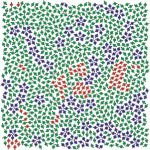
A two-order parameter model proposed to describe water-like anomalies, liquid-liquid transition, glass transition, crystal nucleation and quasicrystal formation within the same framework.
The liquid state of matter is far from being a perfectly disordered homogeneous state. In a Colloquium paper published in EPJ E, Hajime Tanaka argues that to achieve a better understanding of liquids, it is crucial to recognize that a liquid has a general tendency to exhibit local structural order, and that this order is intrinsic and universal to any liquid. In other words, there is a need for a new order parameter describing a low local free-energy configuration (this is a bond-orientational order parameter in many cases), in addition to a density order parameter.




